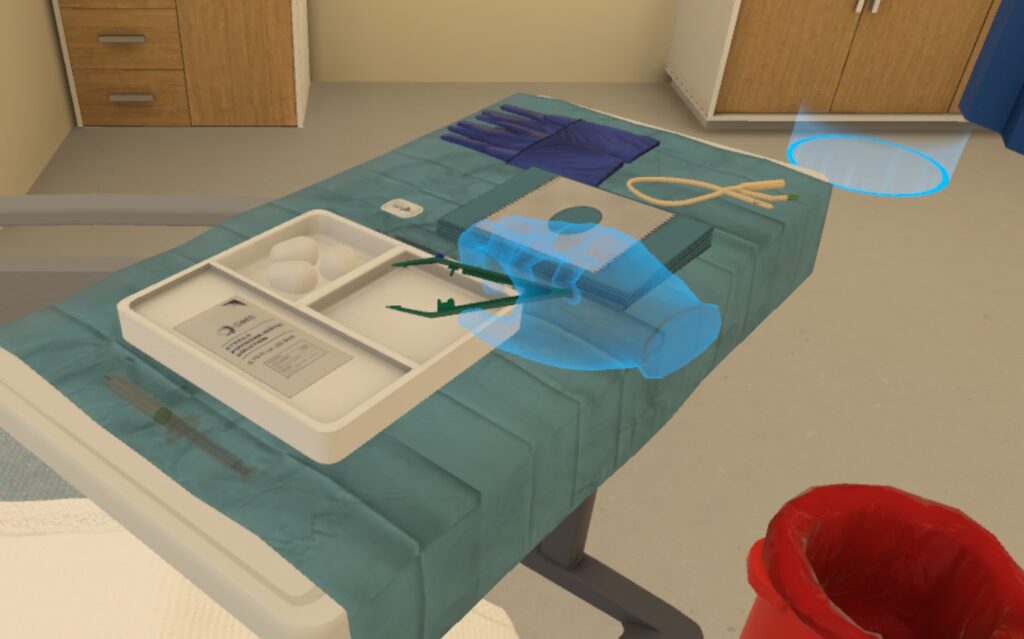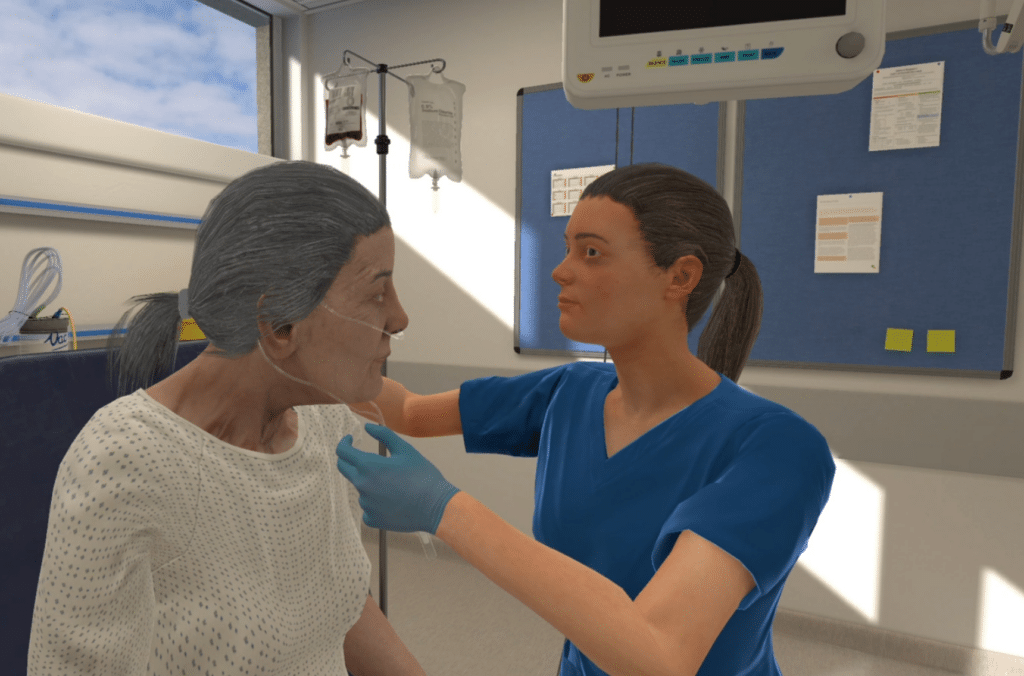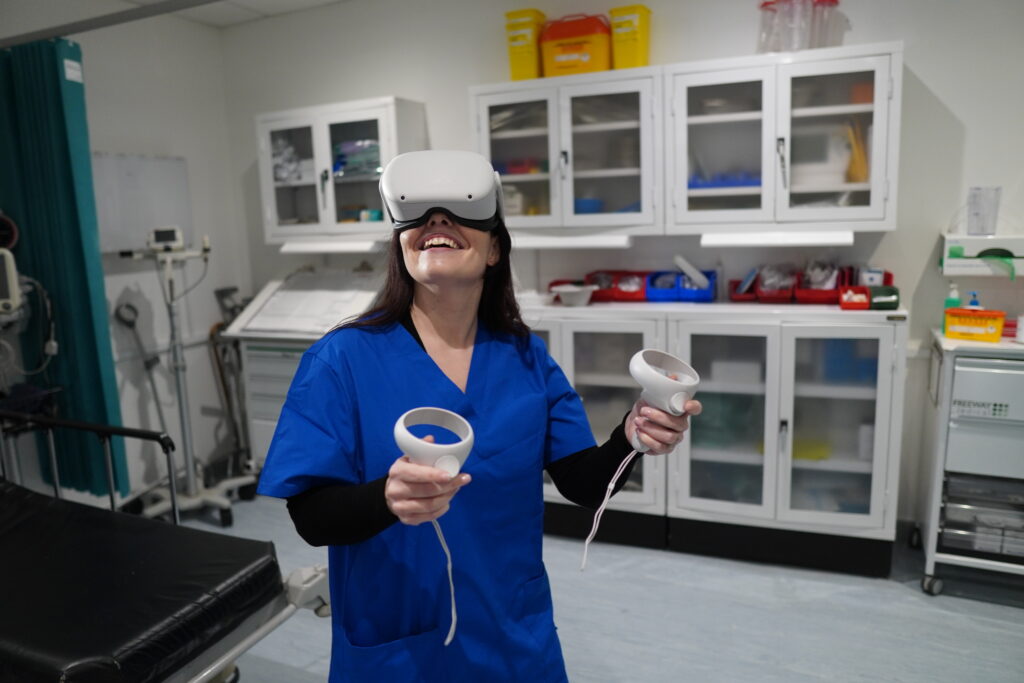Virtual reality is a hot topic these days, particularly in healthcare education and training – and for good reason.
VR scenarios are helping learners across the lifespan of their careers. From junior learners working on building foundational skills to newly licensed practitioners transitioning to practice to advanced clinicians continuing their education, there’s something there for everyone.
The implementation of VR scenarios can provide an immersive and meaningful learning experience that directly impacts learners and ultimately leads to better patient care.
Building confidence in new healthcare professionals
Making the transition from student to fully-fledged healthcare professional is a significant time in a provider’s professional life.
Learning the ropes of a new facility, taking on new responsibilities, and maintaining top-notch care all at the same time can be daunting.
Providing support and ongoing training opportunities can help new healthcare professionals feel more confident in their clinical skills while taking that next step in their careers.
In one study, authors used OMS with their medical trainees in preparation for the management of diabetic emergencies.
Following completion of the OMS scenarios, 100% of learners reported that the experience would improve their daily practice – an exciting insight into how learners feel about using VR to support their clinical practice.
Learners reported that they enjoyed VR and found it helpful for their learning. Practicing in OMS scenarios also improved their confidence. From pre-VR to the 3-month follow-up, learners’ confidence in their ability to manage a diabetic emergency rose by 28%.
Three months after completing the OMS scenarios, 89% of learners reported incorporating the knowledge they gained into their daily practice.
One learner made their feelings clear:
“…honestly, this was the single most useful learning experience I’ve had so far in my medical training.”

With such positive responses from learners, alongside a significant increase in confidence which rose to the level of Kirkpatrick level 3, the authors concluded that VR is both useful and a well-liked educational tool that can support junior doctors in the management of diabetic emergencies.
This study is not the only one to demonstrate how positively learners feel about the use of virtual reality in their learning. In a study by Brown (2023), 100% of learners rated the learning experience highly, and in yet another study by Seager (2021), nearly 96% of participants would recommend VR simulation to their peers.
Additionally, the OMS Library houses a set of scaffolding scenarios specifically designed to facilitate the transition to practice for new nurses.
These scenarios, called OMS Multi-Patient scenarios, provide learners with the unique opportunity to manage multiple patient cases just as expected in practice.
At this stage, learners will focus on providing care to patients with varying levels of complexity to their cases. These situations require learners to prioritize, delegate, and manage care in a timely manner.
The ability to lead patient care as a student preparing for licensure can provide the opportunity for repeated practice of clinical and critical thinking skills. Learners can place themselves directly in the room with a patient, deliberately practicing to better their skills and provide optimal patient care.
With the option to repeatedly practice, learners can build their skills and their confidence, bringing all that with them to the floor when they begin their work in patient care.
Patient-related outcomes
More training options with more frequent access can mean more time spent preparing for emergent clinical situations.
One review reported that 9 of the 11 selected studies on the use of virtual reality in medical education demonstrated improvements in categories such as knowledge, skills, confidence, and empathy.
With VR training, healthcare professionals can build and maintain their skills and immerse themselves in situations they may not often face, requiring quick thinking and timely intervention for positive outcomes.
The early recognition and treatment for sepsis, for example, can lead to better patient outcomes, and nurses in the Carle BroMenn Medical Center have experienced the impact VR training can have on their patient care.
As part of a larger sepsis initiative, nurses underwent training in OMS scenarios to bolster their understanding and management of the condition. The results showed that nurses who participated in this program felt more confident in their ability and competency to manage a case involving sepsis, and the facility reported that the use of OMS scenarios “translated” to their work on the floor.
Another hospital system, Boston Children’s Hospital, found OMS scenarios had a direct impact on nurse preparedness in patient care. The team in the Cardiac ICU at BCH have been using OMS scenarios as part of their onboarding and training processes, familiarizing new nurses with the work environment and preparing them for situations that arise on the floor.
Following training with the OMS modules, one nurse faced a real emergency and attributed her success in that situation to her training with OMS scenarios.
VR can do more than simply help staff train. It can act as another learning tool that engages staff, and helps them build skills and confidence that they take with them as they care for patients.

Continuing education for staff
Current healthcare professionals, regardless of level of experience can gain new insight and benefit from virtual reality as a part of their ongoing education.
For staff, scheduling and completing a required training module may mean taking time out during the day from patient care or during a lunch hour. Not to mention how difficult it can be to align multiple schedules for a day of simulation.
Flexible training options are a must for staff to get all the opportunities they need to continue their training without disrupting the flow of care.
OMS modules, for example, can be completed in a VR headset or on a desktop screen, meaning staff can access scenarios whenever they’re able to. Whether during an unplanned open window of time or at home, truly flexible training means providing staff with multiple avenues to access what they need.
Because of this flexibility, OMS training can be scaled to meet the needs of any number of learners without the hassle of aligning multiple schedules or taking full days to provide simulation experiences.
Learners can also work interprofessionally, even when they’re not in the same location. Teams of people from all departments can work together in the virtual environment, whether they’re five feet apart or across the world from each other.
One study used VR to facilitate team-based training in the management of pediatric sepsis, finding positive results.
Due to the objective nature of the OMS platform, all OMS scenarios are standardized. As facilities are also able to align scenarios with their own protocols, staff can train in a realistic environment that reflects the standards of practice they will maintain at work.
This can mean a reduction in variation in care and an adherence to protocols, as all staff will have the same opportunity to complete VR scenarios.
Continuing education involves learning new skills and maintaining learned skills, keeping fresh for any situation.
While there are many emergent situations that may only arise a handful of times, it remains imperative to be prepared in the event these instances occur.
More simulation, more often, with easier access means more opportunities to individually and intentionally practice clinical skills, which can also increase staff confidence in managing conditions.
Carle BroMenn Medical Center is one such institution using OMS VR scenarios to maintain skills and stay prepared for the early recognition and treatment of conditions like sepsis.
Nurses completing the OMS modules reported an increase in confidence, on average, from 6.6 pre-VR to 8.4 following the sepsis initiative, nearly a 2-point gain across all who participated.
As one nurse put it, “Doing the VR made me feel more confident in treating sepsis, and the biggest reason is because of the feedback.”

What it all means
Appropriate, relevant, and impactful learning experiences can help clinicians at any stage prepare for emergent or difficult situations.
A platform like OMS can assess and track competency, providing real-world insights into readiness to practice and skill progression, standardizing and individualizing the learning experience.
As clinicians can demonstrate competency, build, and maintain skills, they can also build their confidence and apply what they’ve learned to their practice.
This can lead to more timely recognition of arising situations, earlier interventions, and better patient outcomes.
For more information on the outcomes associated with VR training, check out the research page of our site.
